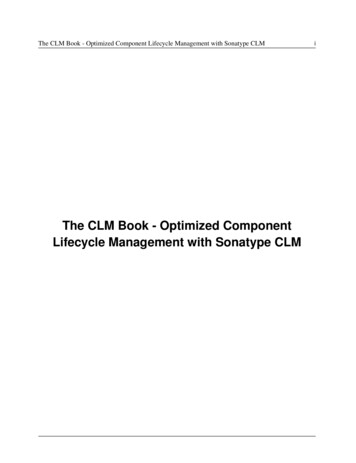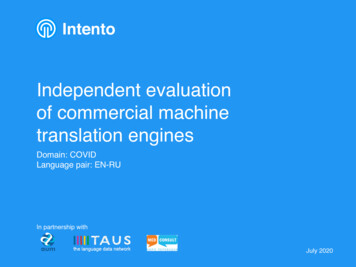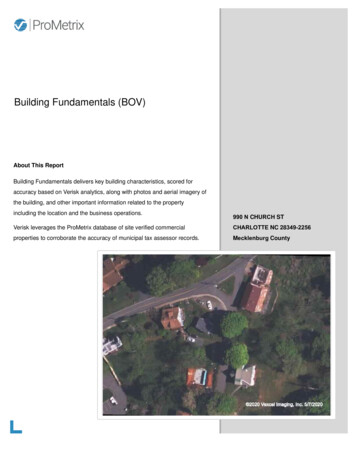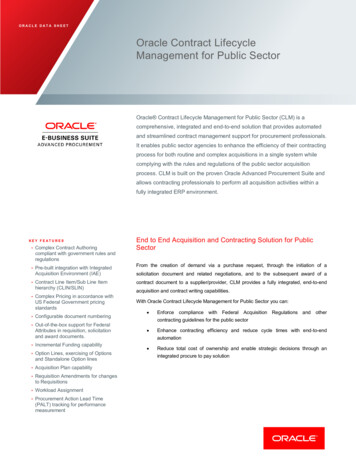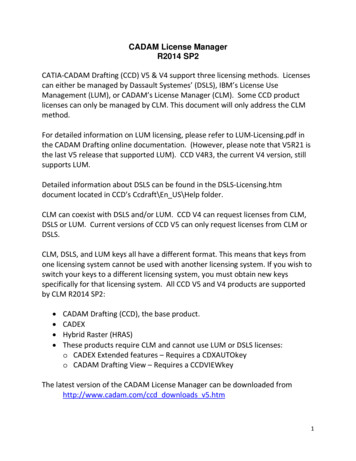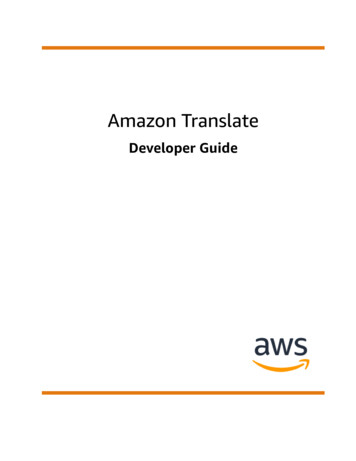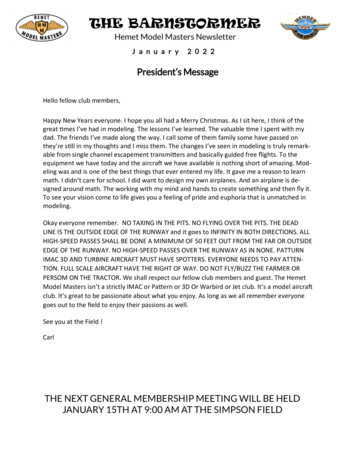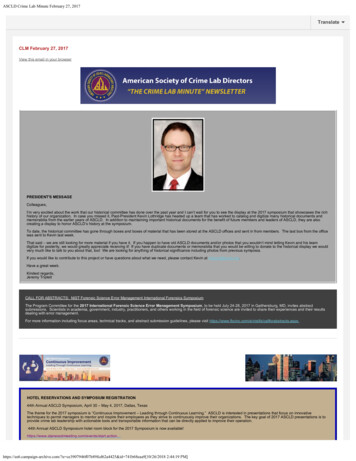
Transcription
ASCLD Crime Lab Minute February 27, 2017TranslateCLM February 27, 2017View this email in your browserPRESIDENT'S MESSAGEColleagues,I’m very excited about the work that our historical committee has done over the past year and I can’t wait for you to see the display at the 2017 symposium that showcases the richhistory of our organization. In case you missed it, Past-President Kevin Lothridge has headed up a team that has worked to catalog and digitize many historical documents andmemorabilia from the earlier years of ASCLD. In addition to maintaining important historical documents for the benefit of future members and leaders of ASCLD, they are alsocreating a display to honor ASCLD’s history at the symposium.To date, the historical committee has gone through boxes and boxes of material that has been stored at the ASCLD offices and sent in from members. The last box from the officewas sent to Kevin last week.That said – we are still looking for more material if you have it. If you happen to have old ASCLD documents and/or photos that you wouldn’t mind letting Kevin and his teamdigitize for posterity, we would greatly appreciate receiving it! If you have duplicate documents or memorabilia that you would be willing to donate to the historical display we wouldvery much like to talk to you about that, too! We are looking for anything of historical significance including photos from previous symposia.If you would like to contribute to this project or have questions about what we need, please contact Kevin at history@ascld.org.Have a great week.Kindest regards,Jeremy TriplettCALL FOR ABSTRACTS: NIST Forensic Science Error Management International Forensics SymposiumThe Program Committee for the 2017 International Forensic Science Error Management Symposium, to be held July 24-28, 2017 in Gaithersburg, MD, invites abstractsubmissions. Scientists in academia, government, industry, practitioners, and others working in the field of forensic science are invited to share their experiences and their resultsdealing with error management.For more information including focus areas, technical tracks, and abstract submission guidelines, please visit aspx.HOTEL RESERVATIONS AND SYMPOSIUM REGISTRATIION44th Annual ASCLD Symposium, April 30 – May 4, 2017, Dallas, TexasThe theme for the 2017 symposium is “Continuous Improvement – Leading through Continuous Learning.” ASCLD is interested in presentations that focus on innovativetechniques to permit managers to mentor and inspire their employees as they strive to continuously improve their organizations. The key goal of 2017 ASCLD presentations is toprovide crime lab leadership with actionable tools and transportable information that can be directly applied to improve their operation.44th Annual ASCLD Symposium hotel room block for the 2017 Symposium is now tart.action https://us6.campaign-archive.com/?u ce3907946f07b89fcd62a4425&id 741b68eaa9[10/26/2018 2:44:19 PM]
ASCLD Crime Lab Minute February 27, 2017http://www.ascldsymposium.com/hoteltravelLinks can also be found on the ASCLD FACEBOOK page at https://www.facebook.com/profile.php?id 100010477606575Sponsorship and ExhibitsThe ASCLD Symposium is an opportunity to meet the industry leading Crime Lab Directors from the United States and throughout the globe. We invite you to take the opportunityto partcipate in the Symposium through networking opportunities in exhibitorsPreview of Symposium Workshops and Key Note Speakers.coming soonGolf Tournament, May 1st, 2017Stevens Park Golf Course –1005 N Montclair Ave, Dallas, TX 75208Join us for a round of golf with your colleagues and the symposium sponsors for a Best Ball tournament and a chance to win a prize! The shotgun start will be at 12:30pm, with abuffet lunch provided beforehand.ASCLD will be assigning teams of 4 ahead of time to allow for networking and new opportunities to be presented for all participants.You can sign up for the golf tournament through our registration system here. You will need to complete a full registration to be signed up for the tournament. The registrationcost of 80/person includes 18 holes of golf, cart fees and lunch. Golf clubs can be rented for an additional charge at the course. Transportation to and from the course is notincluded.See you there!National Commission on Forensic Science Newshttps://www.justice.gov/ncfs/meetingsTop Stories'New joint crime lab to streamlineinvestigationsThe VillagerOfficials say crimes would be solved morequickly and efficiently with the new 15million multi-jurisdictional south metro crimelab now slated to open .Indiana State Police Laboratory ForensicFirearms Identification Unit ReachesMilestone With .WBIW.com(INDIANAPOLIS) - The Indiana State PoliceFort Wayne Laboratory Forensic FirearmsIdentification Unit recently achieved anationally recognized .Meetings of the National Commission on Forensic Science (NCFS) are held quarterly in Washington, DC. NCFSmeetings are open to the public. Public registration for NCFS meetings is available approximately one month inadvance of a meeting and can be found under the respective meeting link. NCFS meetings are also webcast.The thirteenth meeting of the National Commission on Forensic Science will be held April 10-11, 2017 in Washington,DC.If you would like to receive email updates as new information or new materials are added, please subscribe.Email updatesACLU Sues City of San Diego, DemandsSDPD Change Policy Allowing DNACollection From .San Diego Free PressThe long-standing civil rights organizationseeks to change current San Diego PoliceDepartment policy allowing police officers tocollect DNA .Mixed opinions on familial DNA testQueens ChronicleFamilial DNA testing is a type of DNAscreening in which investigators take a . “Ineed to stress that our personal tragedy, inreality, familial DNA is no .Wisconsin Supreme Court rules ontoxicology tests as evidenceOOYUZThe use of toxicology test results againstcriminal defendants in court could becomeeasier, following a ruling by the WisconsinSupreme Court.Bristol County DA's office goes high techwith new digital forensics labThe Sun ChronicleQuinn, with a half-dozen police chiefs andtroopers on hand, unveiled a digitalforensics lab at his office with all the latesttechnological wizardry to .China banning carfentanil March 1News-Herald.comThat's the analogy Douglas Rohde of theLake County Crime Laboratory used todescribe the potency of the “super opiate”OSAC Promotes Hundreds of Forensic Science Standards, Guidelines, and Other Documents During 2017OSAC Public Status Reports & Open Discussions"The Organization of Scientific Area Committees for Forensic Science (OSAC) held the 3rd Annual Public StatusReports & Open Discussions sessions at the American Academy of Forensic Sciences (AAFS) in New Orleans, LAon February 13-14, 2017. At the public meeting the five Scientific Area Committee chairs and 25 SubcommitteeChairs presented their units’ progress to the public, and solicited open discussion on topics presented. NISTpartnered with the National Institute of Justice's (NIJ) Forensic Technology Center of Excellence operated by RTIInternational to broadcast this event to all interested stakeholders. The webcasts and PowerPoint presentations areavailable for public viewing on the NIST OSAC website."To read the full February 2017 OSAC Newsletter, please visit ewsletter-february-2017The OSAC Registry is a trusted repository of high-quality, science-based standards and guidelines for forensicsciences.ASCLD DNA Mixtures Webinar (Managers overview)This webinar is targeted to Laboratory Directors and Managers, Quality Mangers, DNA Supervisors and DNATechnical Leaders.Presenters: Lynn Robitaille Garcia, General Counsel, Texas Forensic Science Commission and Michael D. Coble,Research Biologist, National Institute of Standards and Technologyhttps://us6.campaign-archive.com/?u ce3907946f07b89fcd62a4425&id 741b68eaa9[10/26/2018 2:44:19 PM]
ASCLD Crime Lab Minute February 27, 2017carfentanil to The .Wisconsin Supreme Court: ToxicologyReport Not TestimonialWisBarThe majority noted prior U.S. SupremeCourt decisions involving forensic labreports – Melendez-Diaz v. Massachusetts,557 U.S. 305 (2009) and .GBI plans for new regional crime lab toaddress growing population, caseloadSavannah Morning NewsForensic Chemist Laura Zimmerman teststhe base levels of a cocaine sample at theGBI forensic lab on Mohawk Street. (JoshGalemore/Savannah .Police to review 484 cases after criminalprobe launched at forensics laboratoryEast Lothian CourierAlmost 500 police investigations are beingreviewed after a criminal probe waslaunched into the actions of staff at aforensics lab used by forces .State Police lab speeds up evidence testingfor impaired driving casesAlbany Times UnionALBANY -- The State Police forensiclaboratory has reduced the turnaround timefor evidence testing in impaired drivingcases by 26 percent in two .No. 1 public defender calls possible forensicerrors a 'black eye'WESH OrlandoFingerprint examiner Marco Palacio said hewas one of the best who “never” made amistake in 15 years. However, two weeksago WESH 2 News .Multifunction Centre still unused by policeThe Daily Herald (press release)COLE BAY--The country's first forensic laband professional shooting range at the oldSoremar Building on Orange Grove Road isyet to be used for its .Complex DNA mixtures from more than two individuals and/or profiles amplified with low-level quantities of DNA, canbe challenging for the analyst to interpret. Dr. Coble first provided an overview of the technical issues with mixtureinterpretation including statistical analyses. Ms. Garcia will described the lessons learned in Texas as the stateconfronted one of the forensic DNA community’s elephants in the room—that DNA mixture interpretation ischallenging and laboratories have not always interpreted complex mixtures properly. Ms. Garcia described how Texasbecame aware of the issue, what the Texas Forensic Science Commission did in response and how stakeholdersdeveloped a plan to identify and notify potentially affected defendants in literally tens of thousands of cases. Shediscussed what Texas observed regarding the crucial role of SWGDAM and the accrediting bodies, where the gaps inoversight are and what work remains to be done through the OSAC process. Ms. Garcia made the case for review ofDNA mixture cases by any laboratory that may not have applied statistical methods properly (in particular theCombined Probability of Inclusion/Exclusion) and warned against viewing probabilistic genotyping software as ablackbox savior in light of what Texas has already observed for mixture recalculations using the software.ASCLD DNA Mixtures Webinar: Managers Overview – Archival nect/c1/7/en/events/event/shared/1178106117/event landing.html?sco-id 1206197265& charset utf-8ASCLD DNA Mixtures Webinar Series : Technical OverviewThis webinar is targeted to DNA Technical Leaders, Quality Mangers, DNA Supervisors and DNA Analysts.Presenters: Joel Sutton, the DNA Casework Technical Leader for the United States Army Criminal InvestigationLaboratory; John Buckleton, Principal Scientist for the Institute of Environmental Science & Research Ltd inAuckland, New Zealand; Bruce Heidebrecht, DNA Technical Leader for the Biology Section at the Maryland StatePolice, Forensic Sciences Division and Jerilyn Conway, Federal Bureau of InvestigationsComplex DNA mixtures from more than two individuals and/or profiles amplified with low-level quantities of DNA, canbe challenging for the analyst to interpret. The FBI’s Scientific Working Group on DNA Analysis Methods (SWGDAM)has been crafting a new version of the autosomal DNA STR interpretation guidelines that most of the DNAlaboratories in the country look to for guidance in analyzing DNA profiles. Mr. Sutton presented information on thechanges to the interpretation Guidelines including the background and scope of the changes. Mr. Heidebrecht andMs. Conway also answered questions and provided additional comments. Mr. Buckleton spoke about the PCASTreport and the impact the report is having on the Forensic DNA community.ASCLD DNA Mixtures Webinar: Technical Overview – Archival nect/c1/7/en/events/event/shared/1178106117/event landing.html?sco-id 1206191684& charset utf-8Marshall University Forensic Science is offering the DNA Technical Assistance Program (DNA TAP) again this year.Attached is the DNA TAP Information flyer and the associated DNA TAP Request Form should you have validation orevaluation needs . Beginning this week, a limited number of DNA TAP students are in training at the MU ForensicScience Center from now until May for their summer 2017 DNA TAP assignments. No assignments have been madeat this time so please apply early this fall to have the best chance to be assigned a DNA TAP student.Please feel free to call (304-634-5263) or email (staton1@marshall.edu) should you have questions or wish to applybut need more information. If you are new to this program, I would be happy to set up a conference call with yourgroup to discuss this further.Also, please feel free to forward this email and its attachments to a colleague.Thank you,PamReview the solicitation, ““Research andDevelopment in Forensic Science forCriminal Justice Purposes.” Proposals aredue February 28, 2017.Pamela J. Staton, Ph.D.Professor & Graduate Programs CoordinatorMarshall University Forensic Science1401 Forensic Science DriveHuntington, WV 25701Ph: 304-634-5263 Mobile; 304-691-8931 csNIJ Forensic Science R&D Reports forASCLD Crime Lab Minute Vol 9These research reports have been submittedby the National Institute of Justice (NIJ)especially for their relevance to crimelaboratory activities. ASCLD has notreviewed nor does it necessarily endorse thefindings of this research.Funding Opportunity for Research andDevelopment in Forensic Science forCriminal Justice Purposes NIJ hasreleased a solicitation seeking proposals forbasic and applied research and developmentprojects. The goal of this solicitation is todirect the findings of basic scientific research,research and development in broaderscientific fields applicable to forensic science,and ongoing forensic science researchtoward the development of accurate, costeffective, and rapid methods for theidentification, analysis, and interpretation ofphysical evidence for criminal justicepurposes. Deadline: February 28, 2017 Learnmore about this solicitation in a webinarrecording available soon.Funding Opportunity: Paul CoverdellForensic Science Improvement GrantsProgram – CompetitiveNIJ is seeking proposals for the PaulCoverdell Forensic Science ImprovementGrants Program (the Coverdell program),which awards grants to states and units oflocal government to help improve the qualityand timeliness of forensic science andmedical examiner/coroner’s office services.Among other things, funds may be used toeliminate a backlog in the analysis of forensicevidence and to train and employ forensicBode Cellmark Forensics provides advanced forensicsolutions offering crime labs ways to reduce theirworkloads and budgets.Bode’s newest offerings include:Sexual Assault Kit Backlog Reduction Programstreamlines processes to eliminate backlogs ofuntested sexual assault kits.Bode Buccal 2 is uniquely designed to improveDNA databanking collecting and automateprocessing. The Bode Buccal 2 is a DIRECTCOLLECTION SYSTEM that requires minimaltraining. There is NO Transfer Step Required.Independent Validation Services are customized tomeet your laboratory’s needs. Validation servicesprovide completely unbiased analysis on yourequipment, chemistries, or process.https://us6.campaign-archive.com/?u ce3907946f07b89fcd62a4425&id 741b68eaa9[10/26/2018 2:44:19 PM]
ASCLD Crime Lab Minute February 27, 2017laboratory personnel, as needed, to eliminatesuch a backlog. This funding opportunity isonly for competitive funds. Deadline: March10, 2017 Learn more about this and otherfunding opportunities for crime labs in awebinar recording available soon.Funding Opportunity: Paul CoverdellForensic Science Improvement GrantsProgram – FormulaNIJ is seeking proposals for the PaulCoverdell Forensic Science ImprovementGrants Program, which awards grants tostates to help improve the quality andtimeliness of forensic science and medicalexaminer/coroner’s office services. Amongother things, funds may be used to eliminatea backlog in the analysis of forensic evidenceand to train and employ forensic laboratorypersonnel, as needed, to eliminate such abacklog. This funding opportunity is only forthe formula (“base”) funds. Deadline: March10, 2017 Learn more about this and otherfunding opportunities for crime labs in awebinar recording available soon.Funding Opportunity: Research andEvaluation for the Testing andInterpretation of Physical Evidence inPublicly Funded Forensic LaboratoriesNIJ is seeking proposals for research andevaluation projects that may: 1.) Identify andinform the forensic community of bestpractices through the evaluation of existinglaboratory protocols; and 2.) Have a directand immediate impact on laboratoryefficiency and assist in making laboratorypolicy decisions. The intent of this program isto identify the most efficient, accurate,reliable, and cost-effective methods for theidentification, analysis, and interpretation ofphysical evidence for criminal justicepurposes. Deadline: February 27, 2017 Learnmore about this and other fundingopportunities for crime labs in a webinarrecording available soon.Funding Opportunity: Forensic DNALaboratory Efficiency Improvement andCapacity Enhancement ProgramDemands for forensic DNA analysisincreased every year from 2009 to 2014, witha 28 percent increase in cases submitted toforensic DNA laboratories during that timeperiod. Often, a single case submissionincludes requests for forensic analyses inDNA and non-DNA disciplines. Enhancingcapacity and improving efficiency in theprocessing and testing of non-DNA evidencefrom cases that also involve a request forDNA analysis will ultimately reduce thebacklog of DNA evidence. NIJ’s ForensicDNA Laboratory Efficiency Improvement andCapacity Enhancement (EI&CE) program isintended to help address that gap. Deadline:March 13, 2017 Learn more about this andother funding opportunities for crime labs in awebinar recording available soon.Funding Opportunity: DNA CapacityEnhancement and Backlog Reduction(CEBR) ProgramThe goal of NIJ's FY 2017 DNA CapacityEnhancement and Backlog Reduction(CEBR) program is to assist eligible statesand units of local government to process,record, screen, and analyze forensic DNAand/or DNA database samples and toincrease the capacity of public forensic DNAand DNA database laboratories. Under thisprogram, in general, eligible applicants aregiven the opportunity to determine whatportion of their anticipated funding should beused for capacity building purposes and whatportion should be used for analysis offorensic DNA and/or DNA database samples.Deadline: March 13, 2017 Learn more aboutthis and other funding opportunities for crimelabs in a webinar recording available soon.Funding Opportunity: Strengthening theMedical Examiner-Coroner SystemProgramDeath investigations performed by medicalexaminers or coroner (ME/C) offices are vitalto criminal justice. Of the 2.6 million deathsannually, ME/C offices investigate nearly500,000 cases in approximately 2,400jurisdictions, but many communities lackadequate personnel, infrastructure, andresources to address medicolegal deathinvestigation (MDI) needs. NIJ’sStrengthening the Medical Examiner-CoronerSystem Program is a competitive programdesigned to enhance of MDI services andincrease the supply of forensic pathologistsnationwide by supporting forensic pathologyfellowships as well as ME/C officeaccreditation. Deadline: March 20, 2017Adapting Newborn Blood Testing Proceduresto Forensic ToxicologyChief Forensic Laboratories, Los Angeles County – Medical Examiner- Coroner, Los Angeles, CA, Expires: May 17,2017Forensic Scientist IV, Kansas Bureau of Investigation, Topeka, KS, Expires: March 10, 2017Forensic Scientist – Forensic Biology, Palm Beach County Sheriff’s Office, West Palm Beach, Florida, Expires:February 27, 2017Forensic Biology / DNA Analyst (Part-Time), DuPage County Forensic Science Center, Wheaton, IL, Expires: March10, 2017Latent Fingerprint Examiner, Miami-Dade Police Department, Doral, Florida, Expires: March 6, 2017Forensic Scientist 2-Firearm/Tool Mark Analyst, NM DPS Forensic Laboratory, Santa Fe, New Mexico, Expires:March 12, 2017Forensice Specialist, City of Santa Monica, Santa Monica, Expires: February 27, 2017Forensic Supervisor, City of Santa Monica, Santa Monica, Expires: February 27, 2017Forensic Chemist 2, ORAU, Ft. Gillem, GA & OCONUS, Expires: May 4, 2017Laboratory Manager/Theater Liaison, ORAU, Ft. Gillem, GA & OCONUS, Expires: May 4, 2017Forensic Scientist – Forensic Biology, Virginia Dept. of Forensic Science, Manassas, VA, Expires: February 21,2017Analytical Chemist I – Forensic Chemistry Unit, Division of Forensic Science, WILMINGTON, Expires: March 31,2017Forensic Scientist – Controlled Substances, Virginia Dept. of Forensic Science, Roanoke, VA, Expires: February 24,2017DNA Analyst III, Harris County Institute of Forensic Sciences, Houston, TX, Expires: February 28, 2017DNA Analyst III – Serology / DNA Operations Technician, Harris County Institute of Forensic Sciences, Houston,Texas, Expires: March 23, 2017Assistant Professor of Biological Sciences Forensic Sciences, Ohio Northern University, Ada, Ohio, Expires: March9, 2017Watch the Fremsoc@MOST 2-16 ,There is also a 10-minute YouTube video (previewed at the Forensics@NIST2016 meeting) describing our Souder re-discovery effort.Featured Stories: William SounderFeatured Article:His name was Wilmer Souder. A physicist at the National Bureau of Standards, now known as the National Instituteof Standards and Technology (NIST), Souder played an important role in the early days of forensic science. Hehelped send countless murderers, bootleggers, gangsters and thieves to prison, and he kept such a low profile partlyout of concern for his and his family’s safety. Perhaps as a result, he was not long remembered for his forensic work,and his influence on the developing field of forensic science was not as great as it might have been.NIST Library just finished scanning Souder’s nine notebooks and has made them available for anyone to view via theNIST Digital ng together experts from the forensic, research, legal, and law enforcement communities to strengthen forensicscience and create a safer, more just ceNational Institute of Standards and enceWelcome to the National Software Reference Library (NSRL) Project Web Site.https://us6.campaign-archive.com/?u ce3907946f07b89fcd62a4425&id 741b68eaa9[10/26/2018 2:44:19 PM]
ASCLD Crime Lab Minute February 27, 2017A recent article on NIJ.gov describes aprocedure known as dried blood spot (DBS)testing that can be used in forensic toxicologyexaminations and would benefit both forensiclaboratories and the judicial system. Theresearchers examined dried blood spots forevidence of 28 drugs and metabolites. Thespecific goal of their work was to determine ifDBS analysis could produce resultscomparable to traditional drug analysis and,when combined with mass spectrometry, besensitive enough for quantification of “drugsof abuse” typically encountered in forensiclabs.This project is supported by the U.S. Department of Homeland Security, federal, state, and local law enforcement,and the National Institute of Standards and Technology (NIST) to promote efficient and effective use of computertechnology in the investigation of crimes involving computers. Numerous other sponsoring organizations from lawenforcement, government, and industry are providing resources to accomplish these goals, in particular the FBI whoprovided the major impetus for creating the NSRL out of their ACES program.The National Software Reference Library (NSRL) is designed to collect software from various sources andincorporate file profiles computed from this software into a Reference Data Set (RDS) of information. The RDS canbe used by law enforcement, government, and industry organizations to review files on a computer by matching fileprofiles in the RDS. This will help alleviate much of the effort involved in determining which files are important asevidence on computers or file systems that have been seized as part of criminal research-enables-enhanced-dna-fingerprintsDegraded Ignitable Liquids Database: AnApplied StudyIdentification of ignitable liquid residues in firedebris is complicated by weathering thatcauses the loss of ignitable liquidcomponents and the presence of microbesthat alter the residue’s composition. In thisNIJ-supported project, researchers from theUniversity of Central Florida analyzed theeffects of weathering and biologicaldegradation on 50 different ignitable liquidstaken from each of the ATSM E1618designated classes and selected from theIgnitable Liquids Reference Collection(ILRC). The results of this project led to anupgrade of the ILRC Database and providedfire debris analysts with hundreds ofexamples of weathered and biologicallydegraded ignitable liquid samples.Statistical Methods for CombiningMultivariate and Categorical Data inPostmortem Interval EstimationInferring the time since death is routine indeath investigations, but basing such postmortem interval (PMI) numbers on thedevelopmental stages of maggots and otherinsects is less than straightforward. Thebiological clock provide by insect appearanceand growth in a dead body comes with agreat deal of uncertainty because the sizesand succession combinations of insects differeven when observed under identicalconditions. Researchers at the LouisianaState University Health Sciences Center,working with NIJ support, developed astatistical method using inverse prediction toassess the time since death with areasonable confidence level, most commonlyset at 95 percent. The researchdemonstrated the value of inverse predictionin forensically important settings and how itcan be performed with programs in widelyavailable statistical computing packages.Citrate Content of Bone: A potentialMeasure of Post Mortem IntervalA constant concern for forensic practitionersis the determination of the post-morteminterval (PMI) in questioned death cases. Anumber of methods have been tried to betterdetermine PMI, but all have provenproblematic. NIJ-supported researchers atthe SUNY Brockport Research Foundationevaluated the citrate method for determiningPMI based on a 2010 study that indicatedcitrate content in bone could be potentiallyuseful in estimating PMI. The researchers,with the College at Brockport, SUNY,analyzed more than 30 human bone samplesand determined that the “theoreticalcorrelation between citrate content of boneand PMI is much weaker than reported [in theearlier study]. They also tested porcine bonesamples, but in the end concluded that,“citrate is not a reliable and validated methodfor determining PMI in bone.”Evaluation of Osteometric Measurements inForensic AnthropologyEmphasizing the accuracy of collecting dataand improving error rates for forensicanthropologists working with skeletons, NIJsupported researchers from Lincoln MemorialUniversity had four “observers” with differentexperience levels measure elements of 50skeletons. The error data resulting from themeasurements was used to determine theefficacy of commonly used skeletalmeasurements and to evaluate alternativesfor problem measurements.Graphical User Interface for a MultiFactorial Age-At-Death Estimation MethodUsing Fuzzy IntegralsMost forensic anthropologists develop theirown guidelines, typically based on pastexperience, for combining multiple indicatorsto determine an individual’s age-at-deathbased on a skeleton. Researchers in this NIJsupported project note that such results arenot standardized or reproducible. To addressthis problem the researchers, from TexasState University, developed a graphical userinterface (GUI) with algorithms based on“fuzzy integrals” that provide forensicForensic Science Policy & ManagementCurrent Online Issue ditorialMoving Toward New Requirements for the Admissibility of EvidenceBarry A. J. FisherPages: 51-53Published online: 11 Oct 2016ArticlesDesign Considerations for the Implementation of Artificial Fluids as Blood Substitutes for Educational and Training Usein the Forensic SciencesTheresa Stotesbury, Cathy Bruce, Mike Illes & Robyne Hanley-DafoePages: 81-86Published online: 11 Oct 2016Proficiency Testing Trends Following the 2009 National Academy of Sciences Report, “Strengthening Forensic Sciencein the United States: A Path Forward”Jason Kolowski, Catherine Barden, Catherine Brown, Janine Leete & Christopher CzyrycaPages: 98-105Published online: 11 Oct 2016Risk, Reward, and Redemption: Root Cause Analysis in Forensic OrganizationsMax M. HouckPages: 106-112Published online: 11 Oct 2016Editors-in-ChiefMax M. Houck, Ph.D., FRSCmax@forensicintelligence.usJay A. Siegel, Ph.D.siegel.jay@gmail.comBook Review EditorJay A. SiegelEditorial BoardSusan Ballou – National Institute of Standards an
Reports & Open Discussions sessions at the American Academy of Forensic Sciences (AAFS) in New Orleans, LA on February 13-14, 2017. At the public meeting the five Scientific Area Committee chairs and 25 Subcommittee Chairs presented their units' progress to the public, and solicited open discussion on topics presented. NIST

